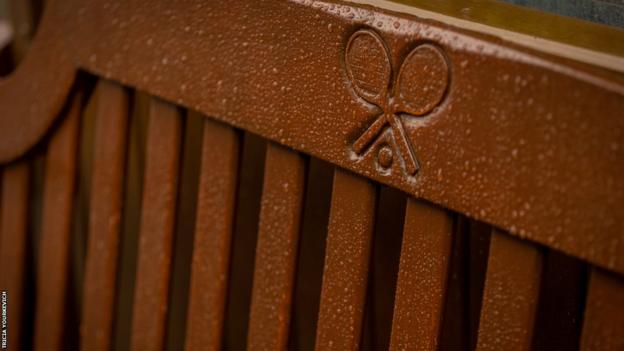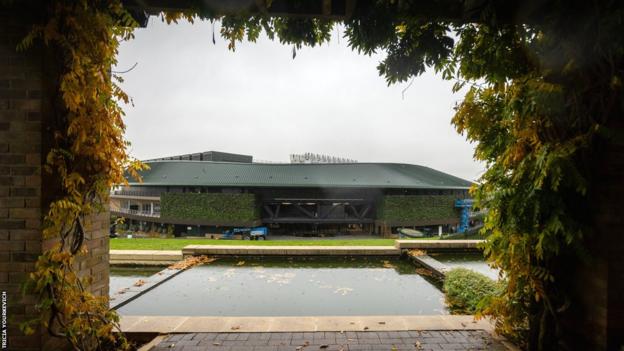
Join notifications to the most recent Perception options by way of the BBC Sport app and discover the latest within the sequence.
Immediately, it’s simply Little Nicky on The Hill.
In seven months or so, will probably be teeming with spectators, sunbathing, sipping and absorbing Wimbledon’s ambiance and giant-screen motion.
However now, as autumn turns in direction of winter, they’re gone. The display is simply too. And Little Nicky – because the All England Membership groundstaff have dubbed their small GPS-guided robotic mower – is alone, trundling up and down the slope, trimming again any new development.
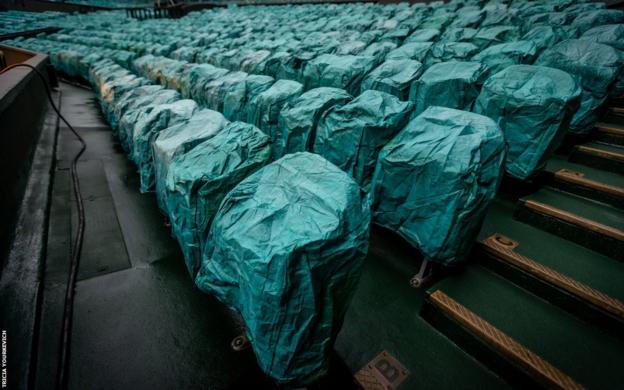
Little Nicky is just not the one distinction. Wimbledon has considered one of sport and summer season’s most recognisable palettes; sun-bleached whites, electrical blue skies, two-tone garden inexperienced and the occasional pop of scarlet strawberry.
Within the drizzle and gloom, with the courts stripped again to reveal postage stamps of turf and the seats hooded in tarpaulin, it’s a extra muted color scheme. Ivy, that blends into the background in the summertime, takes centre stage, wrapping Centre Courtroom in a burnt orange.
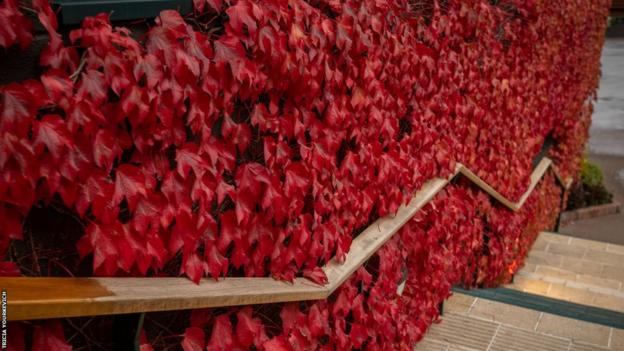
It feels quiet, however, out of sight, loads of work is below manner.
“For me, it’s in all probability as busy as any time of yr,” says Neil Stubley, head of courts and horticulture.
He has simply been at a gathering reviewing July’s championships. It was the twenty eighth Wimbledon that Stubley (under) has labored on since his first, as a scholar, in 1995.
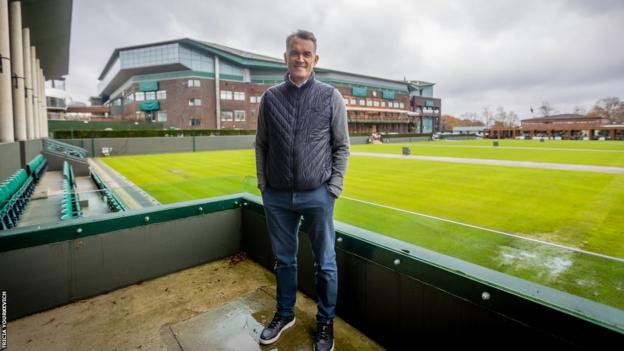
Whereas he additionally has accountability for areas just like the Hill and Wimbledon Park golf course, which the All England Membership purchased in 2018, Stubley’s major focus is identical as most followers; the courts.
“Centre Courtroom might be one of the scrutinised items of turf on this planet,” he says.
“All of us are available with eyes huge open, we all know what the problem is.”
By now, he’ll know extra concerning the problem for 2024. A 200-page doc was set to land in his in-tray shortly earlier than Christmas, postmarked from Bingley, West Yorkshire.
It should include tens of 1000’s of information factors collected by a workforce of three specialists from the city’s Sports activities Turf Analysis Institute. The trio journey down the week earlier than the Championship and take a look at the courts, each morning and night for the next three.
One take a look at includes dropping a ball in choose spots and measuring peak of its bounce. In one other, they insert a probe to completely different depths within the soil to gather moisture content material readings. One analyst will get on their palms and knees to rely the dwelling blades inside a picket quadrant.
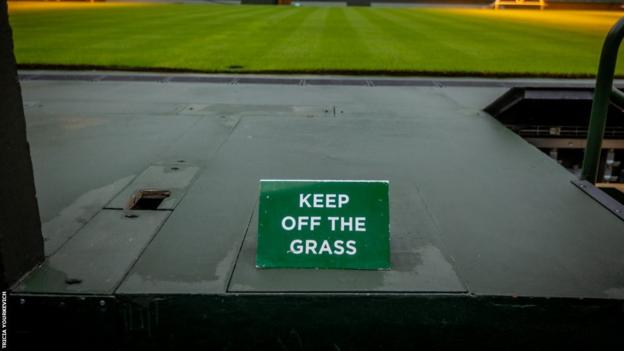
Hidden within the information, Stubley and his workforce will seek for clues as to how they may make the grass final slightly longer or the ball bounce a bit extra persistently subsequent yr.
Quite a bit will depend on the climate. The bottom line is preserving the floor exhausting sufficient for play, whereas locking in sufficient moisture decrease down for the grass to remain alive.
However different elements are even tougher to foretell. London’s foxes prowl the premises at evening and their urine, excessive in nitrates, can scorch the summer season grass.
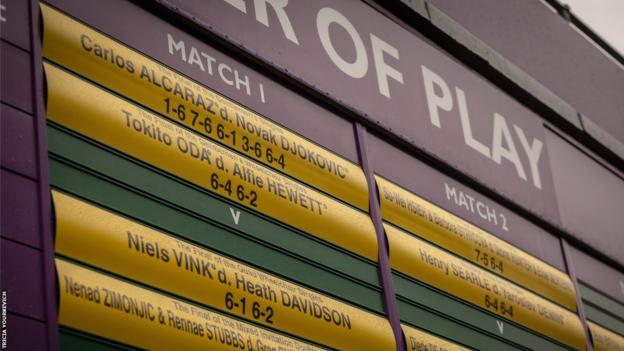
“When you get a rogue patch going off color, you possibly can stick your trusty knife in there, give it a sniff, and you’ll know precisely if a fox has weed on there,” says Stubley.
“You then attempt to dilute it with a load of water, however generally the grass will die. Then it’s a case of placing down what we name ‘groundman’s paint’ – grass clippings.
“That does not have an effect on the play, as a result of the traits of the court docket are within the soil, not the turf.”
Such last-minute touch-ups are removed from the thoughts of Will Brierley, the senior groundsperson who takes care of the Championship courts, in the mean time.
His activity for autumn is the renovation of the courts. Wimbledon is the one Grand Slam performed on a dwelling floor, and likewise the one one hosted by a members’ membership.
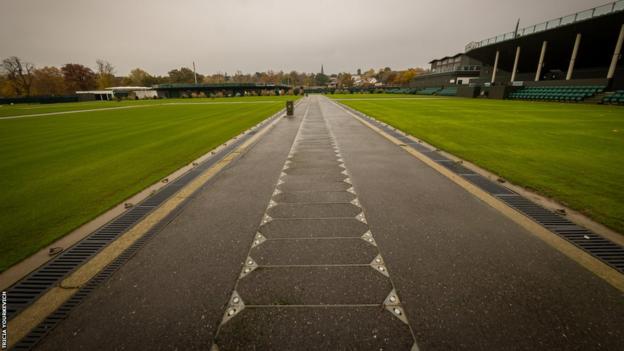
The All England Membership regulars, who complete about 500, play on the surface courts from mid-Could although to mid-September.
When the Championships are over, Brierley and his workforce must juggle preserving courts obtainable to members whereas getting the required repairs accomplished. Now that the complete season is completed, sunlamps bathe baselines in UV gentle. However, regardless, nature nonetheless holds sway.
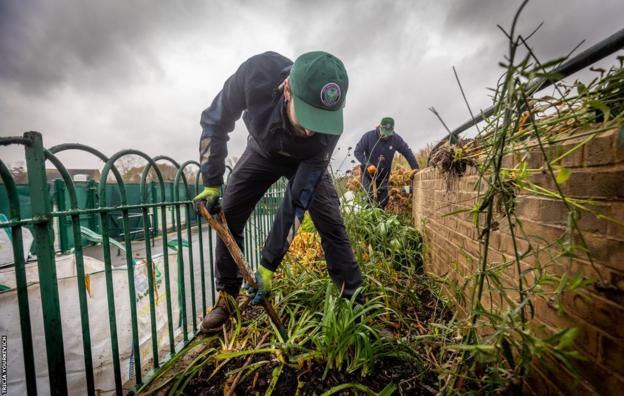
“Every thing in my day-to-day is dictated by the climate,” says Brierley, who admits that his garden at house is “one quarter synthetic turf, three quarters ruined by canine”.
“Tennis is performed on a clay soil so when it rains exhausting it actually restricts what we are able to do.
“When it’s hammering down it’s a case of getting on high of tidying the storeroom, auditing equipment, coaching workers and checking instruments.
“It could actually get a bit tedious and irritating. This yr we had a really moist October and begin of November.
“We may have accomplished with one other week or so of dry climate. Then I believe we might have been precisely the place I would like us to be.”
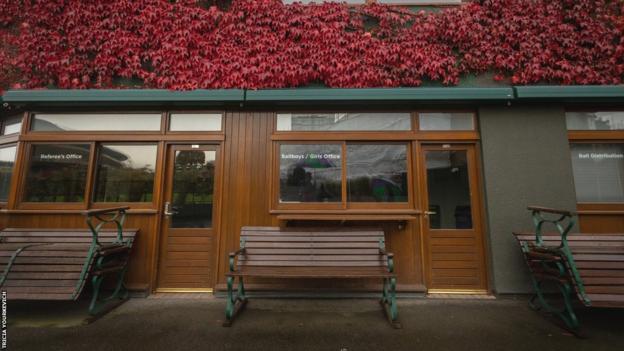
Martyn Falconer has slightly extra freedom from the forecast. As head gardener, he’s answerable for the 50,000 vegetation that enhance the 42-acre website, fulfilling Wimbledon’s promise of staging “tennis in an English backyard”.
Regardless of the climate, there are hedges to trim, weeds to drag or compost to dig in. Ten thousand bulbs have simply been planted. They may emerge, bloom and die again, all unseen by the half 1,000,000 or extra spectators who arrive later within the yr throughout the Championship fortnight.
Weekly deliveries of vegetation in anticipation of the match, all logged in a grasp spreadsheet by Falconer, start in early Could and proceed proper as much as the beginning of the Championships in July. The questions – from suppliers and others – begin lengthy earlier than.

“The stress slowly ramps up,” he says. “Everybody comes again from Christmas and realises we’ve got bought a Championship!
“I’ve been right here lengthy sufficient to understand what’s coming. It feels fairly quiet, however it’s simply brewing…”
Falconer is making an attempt to remain in entrance of one other development – the hotter, wetter winters and warmer, drier summers attributable to local weather change.
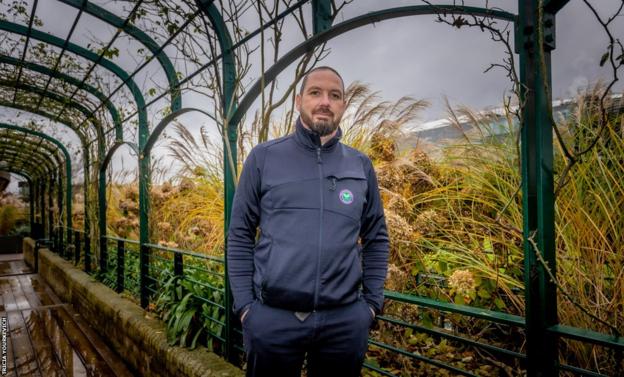
“The warmer summers imply we’re vegetation that may work properly with much less water,” he says.
“It has actually bought hotter within the 24 years since I began right here.
“In earlier autumns I might be out on the instruments, slicing hedges or tidying leaves and it was actually chilly. I might be all wrapped up. Now you may get away with only a jacket, you might be extra nervous about staying dry than staying heat.”
Nevertheless the situations fluctuate, for a lot of of its followers, Wimbledon is a continuing; a manicured nook of England which they’ll rely on summer season after summer season, yr after yr.
“There was a letter a number of years in the past that sticks in my thoughts,” Falconer says.
“It was from somebody who comes again yearly. She used to benefit from the rose arbour together with her husband. He has since died however she nonetheless comes again and sits there yearly and enjoys it. She simply stated the way it wonderful it at all times seems to be.
“Little issues like which can be so good.”
